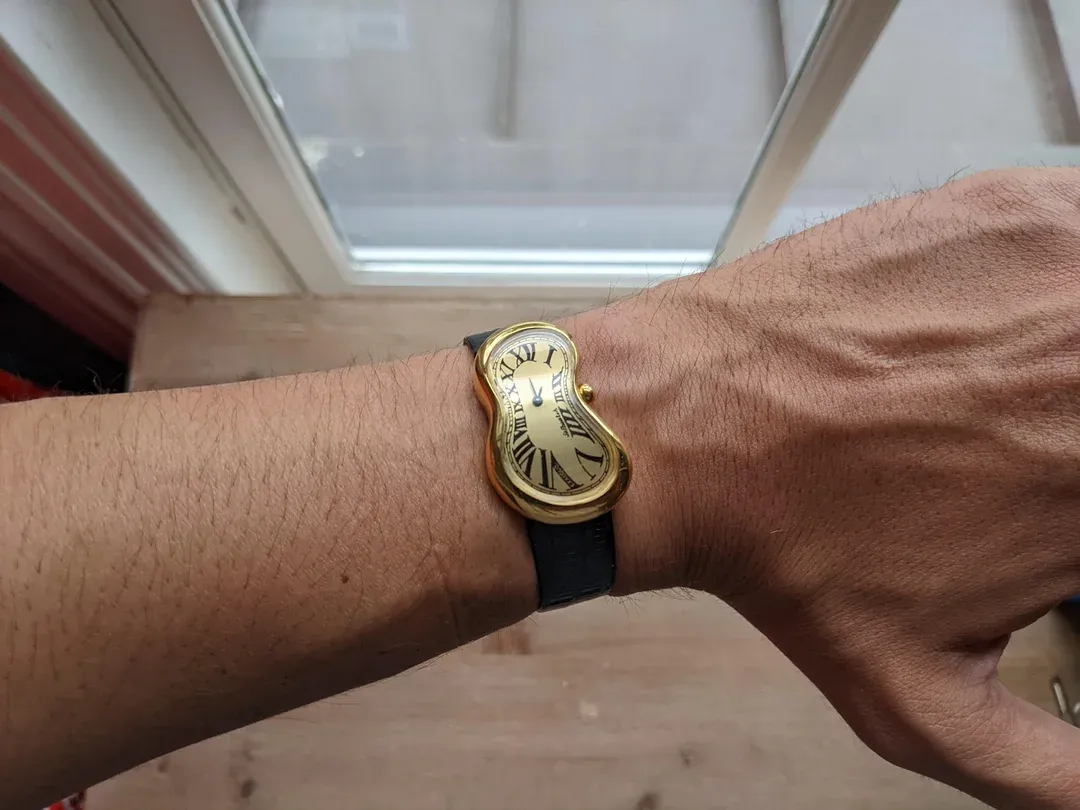The Cartier Crash’s story begins in London in 1967, during a period when the world was captivated by the counterculture movement, and traditional forms were being questioned and reshaped across art, fashion, and even watchmaking. Legend has it that the design was inspired by a Cartier Baignoire watch that was distorted in a car accident—a tale that’s as much myth as it is marketing genius. The actual origin, though, is credited to Jean-Jacques Cartier and designer Rupert Emmerson, who sought to create a timepiece that captured the surrealism and rebellious spirit of the era.
The design of the Crash is like nothing else in the world of horology. The watch’s most striking feature is its asymmetrical, melted appearance, which evokes Salvador Dali’s "The Persistence of Memory" with its melting clocks. The elongated, warped dial and case look like they’ve been exposed to intense heat, bending time and space in a way that’s both unsettling and mesmerizing. The curved Roman numerals further accentuate the watch’s surreal form, bending and twisting to follow the contour of the case. This is not a watch for those who seek precision in their aesthetic; it’s for those who appreciate the art of imperfection and the beauty of the unusual.

For much of its early life, the Crash remained a rare and somewhat obscure piece, beloved by those in the know but largely unknown outside of dedicated watch circles. However, in recent years, it has seen a resurgence in popularity, thanks in part to its adoption by high-profile celebrities. This sudden burst of popularity can be traced back to a broader trend in the luxury market where rarity and uniqueness are prized above all. The Crash, with its limited production and unconventional design, fits the bill perfectly.

For example, when Twitch streamer Kai Cenat flaunted his vintage Crash on a live stream last week, it wasn’t just a display of wealth but a signal of his entry into an elite club of cultural tastemakers. Almost on the same day, the Lakers' LeBron James sported a $300,000 Crash Skeleton courtside after wearing it at the Olympics. It wasn’t just about keeping time; it was about making a statement.

This celebrity endorsement has certainly boosted the Crash’s profile, but it also raises a question: Has the Cartier Crash reached its peak? Some enthusiasts argue that the watch has become overexposed, losing some of its mystique as it becomes more widely recognized. After all, what was once a quirky and rare find has now been transformed into a hot commodity, with prices at auction reaching astronomical heights. The danger here is that the Crash might follow in the footsteps of other luxury items that became too popular for their own good, crossing the line from iconic to pedestrian.
This line of thinking, of course, has inspired numerous homages, with the Exaequo Softwatch standing out as a notable example. Introduced in 1990, the Softwatch takes this inspiration further, embodying the surrealism that Dalí himself made famous.Despite its artistic flair, the Softwatch faced legal troubles for using Dalí’s signature without permission, leading to the brand's closure in 1998. However, this hasn’t stopped collectors from seeking it out. Recently, the Softwatch has seen a resurgence in popularity, much like the Crash, with prices climbing steadily as more people discover its unique design and connection to Dalí’s legacy.

The Softwatch, like other brands influenced by Cartier’s bold designs, has found its place in the market as an accessible yet distinctive alternative to the Crash. While it may not hold the same prestige, it offers a unique charm and serves as a testament to the enduring impact of the Cartier Crash’s revolutionary design on the world of watchmaking.






